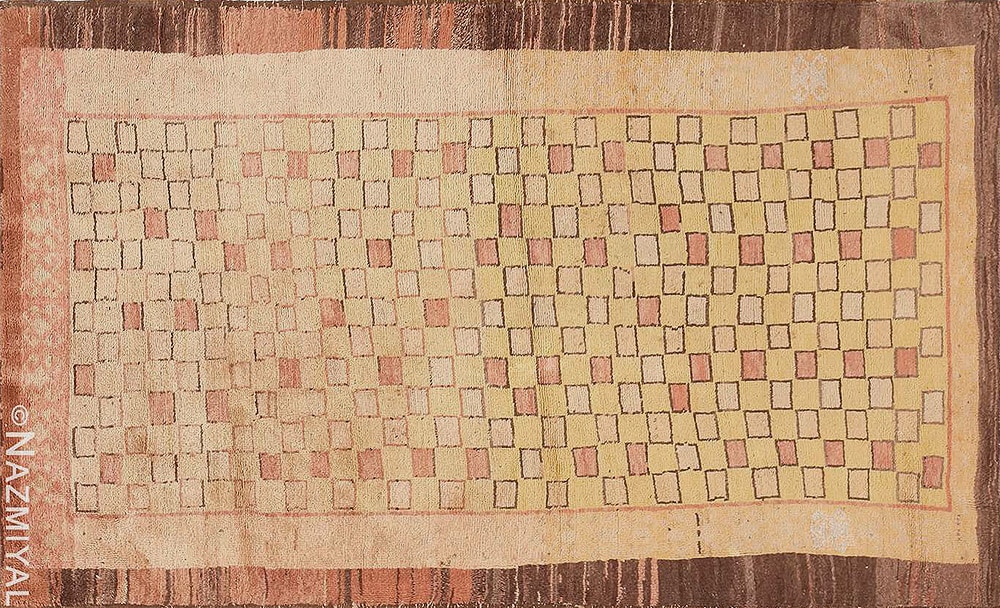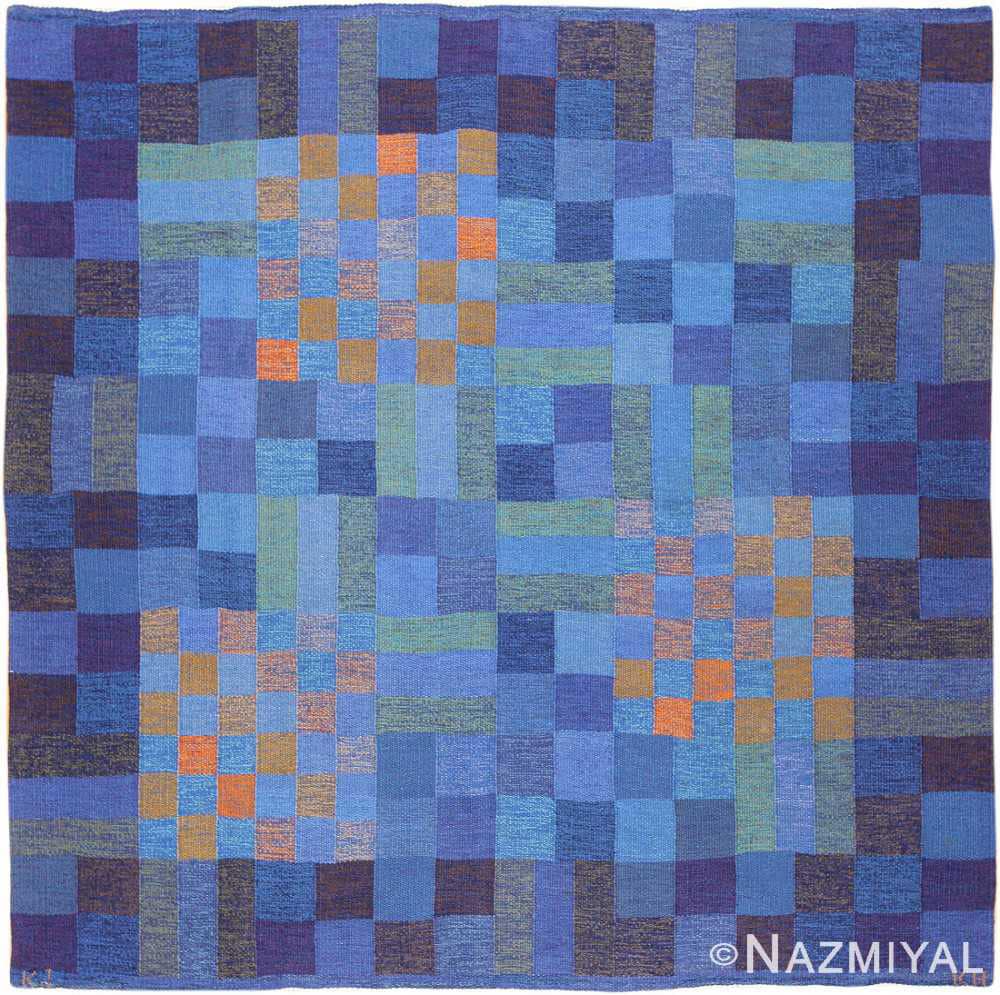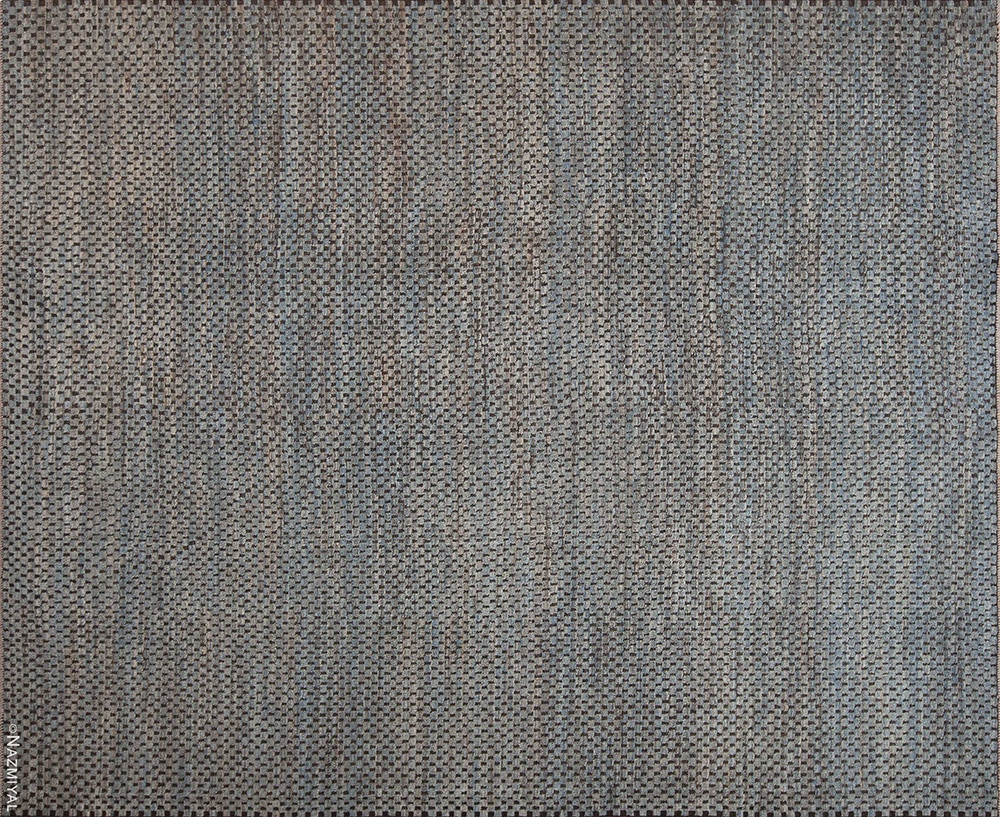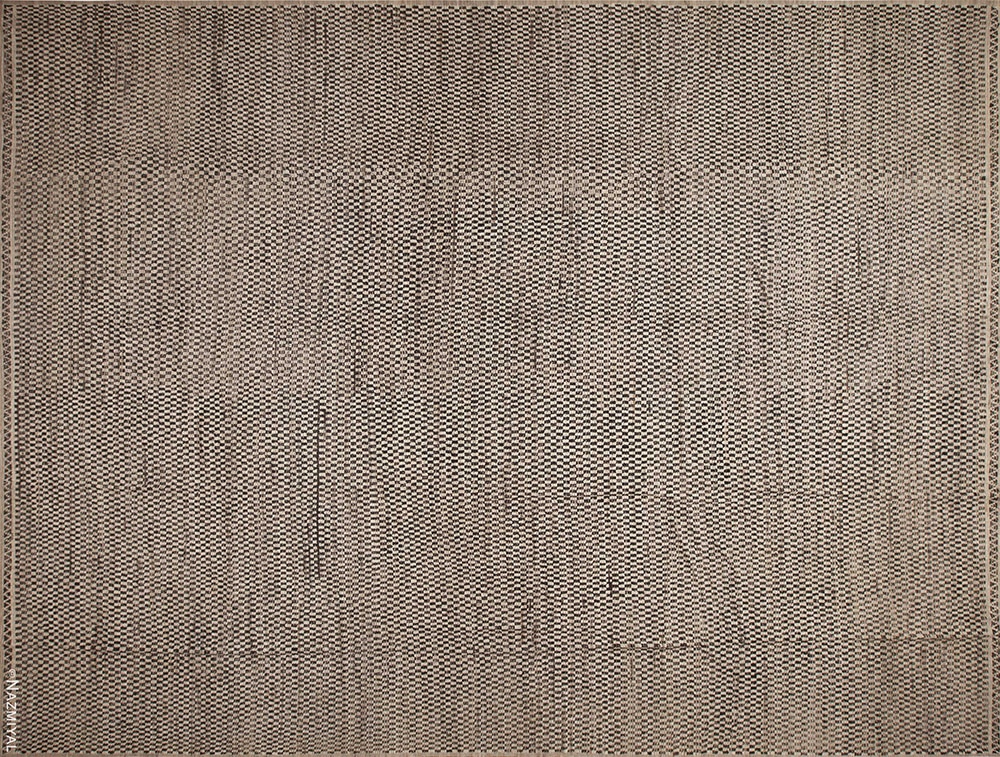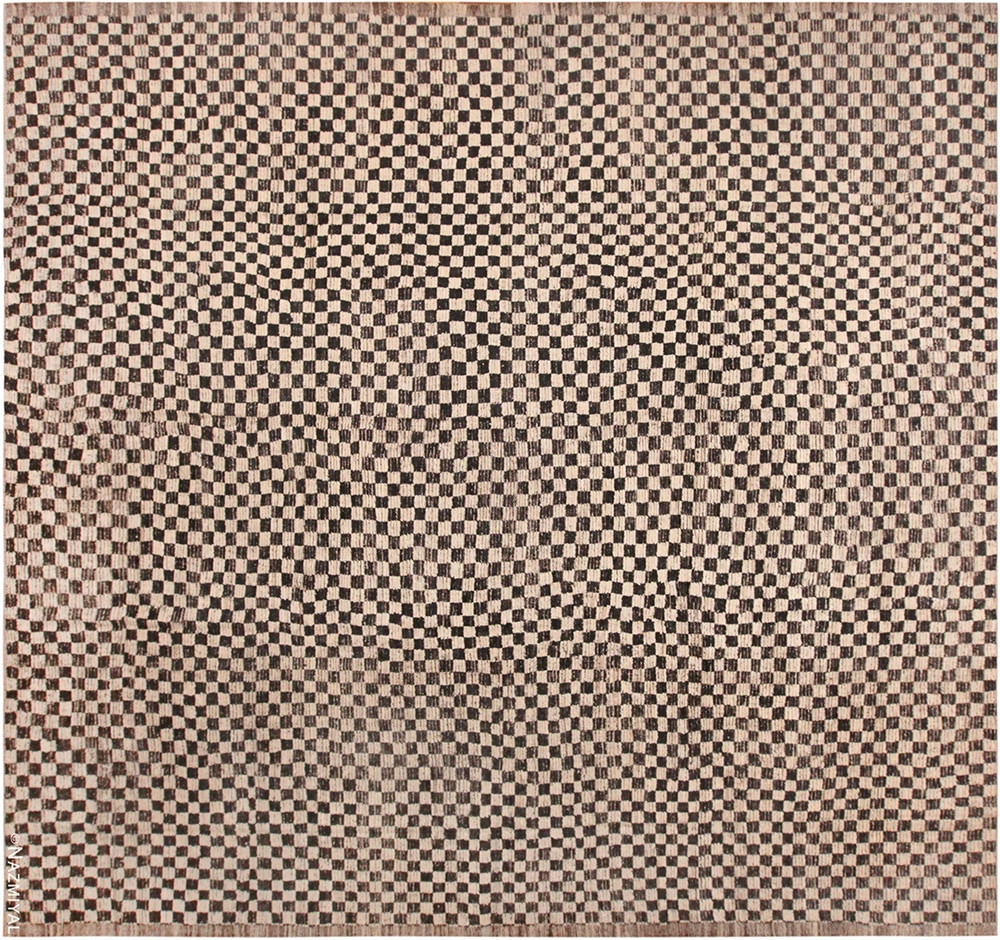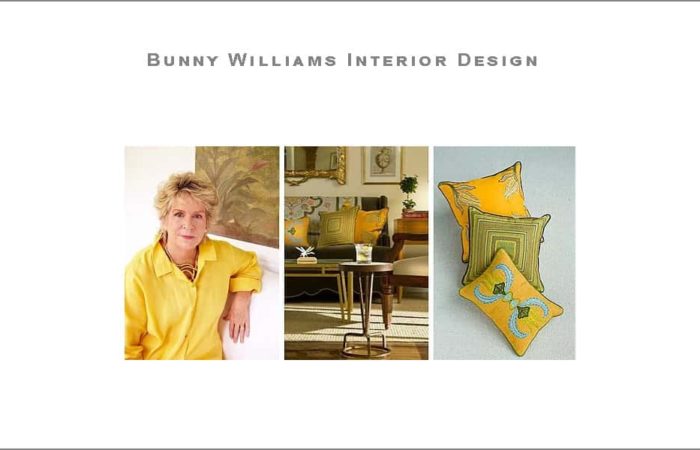Lets explore the recent checkerboard rugs, checkered decor and interior design trends
Shop All Antique Rugs | Shop All Vintage Rugs | Shop All Modern Rugs | Create Your Own Unique Checkered Custom Rugs
What is Checkerboard Decor?
Checkerboard decor and checkered interior design typically refers to a decorative pattern that resembles a checkerboard, which is a square pattern made up of alternating colored squares. This pattern is often associated with the game of checkers, where players move pieces on a board with a similar design.
In home decor, a checkerboard pattern can be applied to various elements, such as floors, walls, furniture, accessories and of course – checkerboard rugs. Commonly, black and white or contrasting colors are used to create the classic checkerboard look. However, checkerboard patterns can also be found in different color combinations, allowing for a more personalized and modern aesthetic.
Checkerboard decor can be used in various design styles, from traditional to contemporary, and it can add a playful and visually interesting element to a space. It’s a versatile pattern that can be incorporated in different ways to achieve different effects, depending on the overall design goals and preferences.
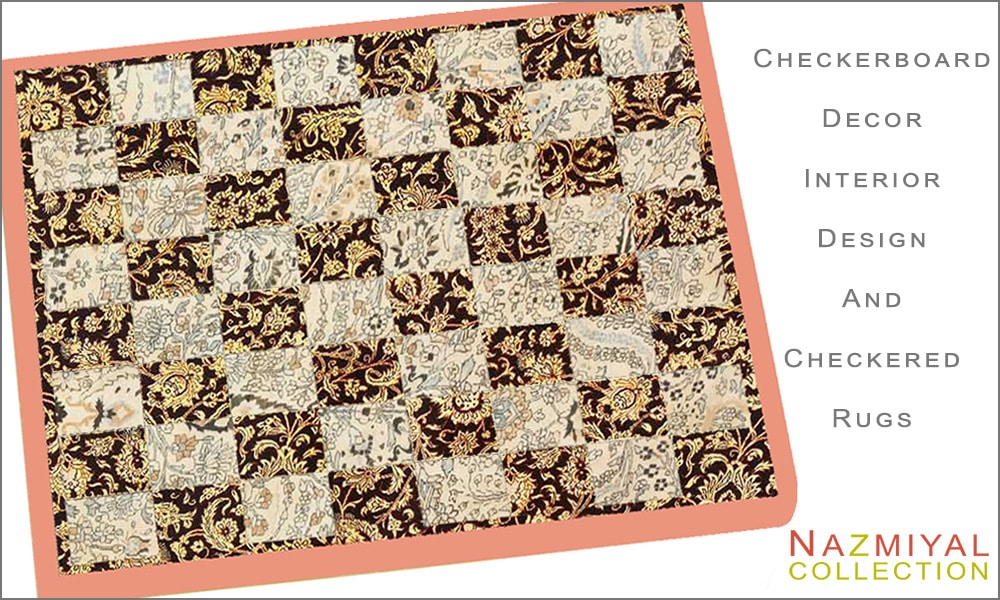
Checkerboard Rugs, Interior Design And Checkered Decor
What is Checkerboard interior design?
Checkerboard interior design refers to the use of a checkerboard pattern in the design and decoration of interior spaces. This pattern typically consists of alternating squares in two contrasting colors, often black and white, creating a grid-like appearance similar to a checkerboard used in the game of checkers.
Here are some ways checkerboard patterns can be incorporated into interior design:
- Flooring: Checkerboard patterns are commonly used in flooring, where tiles, hardwood floors, or other materials are arranged in a checkerboard layout. This can create a bold and visually striking effect, especially in entryways, kitchens, bathrooms, or other areas where the floor is a prominent feature.
- Walls: Checkerboard patterns can be applied to walls through the use of paint, wallpaper, or wall tiles. This can be an effective way to add a dynamic and graphic element to a room, whether it’s a single accent wall or the entire room.
- Furniture: Checkerboard patterns can be incorporated into furniture design. For example, a table, dresser, or cabinet might feature a checkerboard design on its surface.
- Textiles: Checkerboard patterns can be found in textiles such as area rugs, Persian carpets, upholstery, and curtains. These elements can be used to introduce the pattern in a more subtle and versatile way.
- Accessories: Checkerboard patterns can be applied to various accessories and decor items like throw pillows, vases, or artwork, adding a touch of visual interest to the space.
Checkerboard interior design can be applied in a variety of styles, from traditional to contemporary, and it offers a timeless and classic aesthetic. While the black and white combination is a classic choice, designers may also use different color combinations to achieve a more customized or modern look. The key is to balance the pattern with the overall design scheme of the space, ensuring a cohesive and harmonious result.
What is the significance of the checkered pattern?
The checkered pattern, often associated with a checkerboard design, holds significance in various cultural, historical, and symbolic contexts.
Here are some of the key aspects of the checkered pattern’s significance:
- Historical Roots: The checkered pattern has ancient roots and has been used in different cultures throughout history. It can be found in architectural designs, textiles, and artwork from various civilizations.
- Game Symbolism: The checkered pattern is closely tied to traditional board games like checkers and chess. In these games, the pattern serves as the playing board, representing strategy, competition, and intellectual challenges.
- Racing and Flags: The checkered flag is a universal symbol in motorsports, particularly in racing. The pattern is associated with the finish line, signifying the end of a race. The use of checkered flags has become a standard practice in racing events worldwide.
- Symbol of Duality: The dual-color nature of the checkered pattern (typically black and white) can symbolize duality or opposing forces coming together. This symbolism is often seen in yin and yang concepts, where contrasting elements are interconnected and complementary.
- Traditional Fashion: The checkered pattern has been a popular motif in fashion for many years. It has been used in various clothing items, including shirts, skirts, and accessories. The pattern’s timeless appeal contributes to its continued presence in the fashion industry.
- Flooring and Architecture: Checkerboard patterns have been used in flooring and architectural designs for centuries. The pattern can be found in historical buildings, palaces, and cathedrals, often conveying a sense of grandeur and sophistication.
- Symbol of Order: The regular and symmetrical arrangement of squares in a checkered pattern can symbolize order and organization. This symbolism has been utilized in various design contexts, including interior design and architecture.
- Artistic Expression: Artists and designers often use the checkered pattern for its visual appeal and versatility. It can be employed in various art forms, from paintings to sculptures, to create dynamic and visually interesting compositions.
- Cultural and Ethnic Significance: In some cultures, the checkered pattern holds specific cultural or ethnic significance. It may be used in traditional clothing, textiles, or decorative arts as a symbol of identity and heritage.
Overall, the significance of the checkered pattern is multifaceted, with its meaning often depending on the context in which it is used. Whether in games, sports, fashion, or art, the checkered pattern has proven to be a timeless and versatile design element with cultural resonance and symbolic depth.
Why do so many people like the checkerboard design pattern?
The checkerboard design pattern has enduring popularity for several reasons:
- Classic Appeal: The black-and-white checkerboard pattern is a classic design that has been used for centuries. Its timeless and iconic look adds a sense of tradition and familiarity to a space, making it appealing across different design styles.
- Versatility: Checkerboard patterns are versatile and can be adapted to various design elements, including flooring, walls, furniture, textiles, and accessories. This adaptability allows people to incorporate the pattern in different ways to suit their preferences and the overall aesthetic of a space.
- Bold Contrast: The high-contrast nature of the checkerboard pattern, especially in black and white, creates a bold and visually striking effect. This contrast can add drama and interest to a room, making it a popular choice for those who want to make a statement with their interior design.
- Timeless Elegance: The checkerboard pattern exudes a sense of elegance and sophistication. Its simplicity and clean lines contribute to a polished and refined look that can elevate the overall aesthetic of a space.
- Nostalgia: For many people, the checkerboard pattern may evoke feelings of nostalgia, reminiscent of classic games like checkers or chess. This nostalgic connection can make the pattern feel comforting and familiar.
- Visual Interest: The grid-like structure of the checkerboard pattern naturally draws the eye and adds visual interest to a space. This makes it an effective design choice for creating focal points or enhancing specific areas within a room.
- Adaptability to Color Schemes: While the classic black-and-white combination is widely popular, checkerboard patterns can also be adapted to different color schemes. This flexibility allows individuals to personalize the pattern to match their preferred color palette and style.
- Transcends Design Trends: Checkerboard patterns have the advantage of transcending design trends. While they can be incorporated into contemporary settings, their enduring appeal means they won’t quickly go out of style, making them a safe and long-lasting design choice.
Ultimately, the checkerboard design pattern appeals to a wide range of people due to its timeless nature, versatility, and ability to evoke both classic and contemporary aesthetics. Whether used as a focal point or as subtle accents, the checkerboard pattern continues to be a popular choice in interior design.
What goes well with checkered pattern?
The checkered pattern is versatile and can be paired with various elements to create different aesthetic effects.
Here are some ideas on what goes well with a checkered pattern:
- Neutral Colors: Incorporating neutral colors, such as white, gray, or beige, can help balance the boldness of a checkered pattern. This is especially true for larger surfaces like floors or walls where the pattern is prominent.
- Solid Colors: Pairing checkered patterns with solid colors can create a visually appealing contrast. Consider using furniture, textiles, or accessories in solid colors that complement the hues present in the checkered pattern.
- Natural Materials: To add warmth and texture, consider incorporating natural materials like wood or stone. Wooden furniture or flooring can complement the classic look of a black-and-white checkered pattern, while stone elements can enhance a more rustic or outdoorsy vibe.
- Metallic Accents: Adding metallic accents, such as gold, silver, or brass, can bring a touch of glamour to a space with a checkered pattern. This is particularly effective in spaces like kitchens or bathrooms.
- Bold Colors: If you want to make a statement, pair the checkered pattern with bold and vibrant colors. This works well in smaller doses, such as with accessories or accent furniture.
- Pattern Mixing: Embrace pattern mixing by combining the checkered pattern with other geometric or floral patterns. The key is to maintain a sense of balance and coordination in terms of color and scale.
- Vintage or Retro Elements: The checkered pattern has a timeless quality that pairs well with vintage or retro elements. Consider incorporating retro design furniture, mid-century modern style pieces, or vintage accessories to enhance the overall aesthetic.
- Minimalist Decor: For a clean and modern look, pair the checkered pattern with minimalist decor. Opt for simple, streamlined furniture and keep the color palette restrained to maintain a sense of simplicity.
- Accent Colors: Choose a couple of accent colors that complement the checkered pattern and use them strategically throughout the space. This can create a cohesive and harmonious look.
- Greenery: Incorporate plants or greenery to bring a natural and refreshing element to the space. The vibrant green color can contrast nicely with the black-and-white checkered pattern.
Remember, the key to successful design is achieving balance and cohesion. Experiment with different combinations, and consider the overall style and mood you want to convey in your space. Whether you prefer a classic, contemporary, or eclectic look, there are various ways to complement and enhance the checkered pattern in your design scheme.
What is the meaning of checkered color?
The meaning of checkered colors, especially in a black-and-white pattern, often involves a combination of contrasting elements.
Here are some common interpretations of the checkered color pattern:
- Contrast and Balance: The black-and-white checkered pattern symbolizes a sharp contrast between light and dark. This duality suggests balance, equilibrium, and the harmonious coexistence of opposing forces.
- Timelessness and Classicism: The black-and-white checkered pattern is considered a classic and timeless design choice. It has been used throughout history in various contexts, conveying a sense of enduring elegance and sophistication.
- Polarity and Duality: The stark contrast between black and white squares represents a clear division and duality. This can symbolize the interconnectedness of opposing forces, such as yin and yang, or positive and negative aspects.
- Symbol of Clarity: The clear distinction between black and white squares in a checkered pattern can symbolize clarity, precision, and order. This symbolism is often associated with a well-defined and organized structure.
- Crisp Aesthetics: The clean and crisp aesthetics of the black-and-white checkered pattern evoke a sense of cleanliness and clarity. This can contribute to a visually striking and well-defined design.
- Dynamic Visual Impact: The dynamic visual impact of the checkered pattern, especially in black and white, draws attention and creates a bold statement. It can be seen as a powerful design choice, commanding focus and adding interest to a space.
- Versatility: The neutral nature of black and white makes the checkered pattern highly versatile. It can be easily integrated into various design styles and color schemes, allowing for adaptability in different contexts.
- Symbol of Precision and Order: The precise arrangement of squares in a checkered pattern can symbolize precision and order. This symbolism is often applied in design and architecture to convey a sense of well-organized structure.
- Symbol of Unity: The harmonious arrangement of black and white squares in a checkered pattern can symbolize unity and balance. This symbolism is rooted in the idea that contrasting elements can come together to create a cohesive and integrated whole.
It’s important to note that individual interpretations of the checkered color pattern can vary based on personal experiences, cultural backgrounds, and the specific context in which the pattern is used. As with any symbol or design element, the meaning may be subjective and open to different interpretations.
Are Gingham and checkered pattern designs the same thing?
While both gingham and checkered patterns involve a grid of squares, they are not the same thing. The primary distinction lies in the specific characteristics of each pattern.
- Checkerboard or Checkered Pattern:
- Description: Checkerboard patterns consist of squares of two contrasting colors, often black and white, arranged in a regular, alternating grid.
- Versatility: Checkerboard patterns are highly versatile and can be used in various contexts, including flooring, clothing, accessories, and interior design.
- Gingham Pattern:
- Description: Gingham is a specific type of checkered pattern characterized by evenly spaced, same-sized checks or squares. These checks are typically of two colors, with one color forming the horizontal stripes and the other forming the vertical stripes.
- Fabric Association: Gingham is commonly associated with woven cotton or linen fabrics and is often used in clothing, particularly in shirts and dresses.

Gingham is a specific type of checkered pattern characterized by evenly spaced, same-sized checks or squares
In summary, while both checkerboard and gingham patterns involve a grid of squares, gingham specifically refers to a type of checkered pattern with evenly spaced and same-sized checks, often associated with woven fabrics. Checkerboard patterns, on the other hand, can vary in scale, color combinations, and context, appearing in a broader range of applications beyond textiles.
Are Houndstooth and checkerboard patterns the same thing?
While both houndstooth and checkered patterns involve a grid-like arrangement of contrasting colors, they are distinct patterns with different visual characteristics.
- Checkered Pattern:
- Description: Checkered patterns consist of evenly spaced squares or checks in two contrasting colors, such as black and white. The squares are typically of the same size and form a regular grid.
- Versatility: Checkered patterns are highly versatile and can be found in various scales and contexts, including flooring, clothing, accessories, and interior design.
- Houndstooth Pattern:
- Description: Houndstooth is a distinct pattern characterized by broken or abstract four-pointed shapes, often resembling the teeth of a hound. The pattern typically features two contrasting colors, but the design is more intricate and has a different overall appearance compared to a simple checkered pattern.
- Versatility: Houndstooth is often associated with textiles, especially in fashion. It is commonly used in garments like suits, coats, and skirts.

Houndstooth is a distinct pattern characterized by broken or abstract four-pointed shapes
While both patterns are classic and have been used in fashion and design for many years, the visual differences between checkered patterns and houndstooth patterns are evident. Checkered patterns are formed by squares, whereas houndstooth patterns feature more complex, irregular shapes that create a distinctive overall look.
Are black and white checkered patterns the same as Sillitoe tartan?
No, the black and white checkered pattern is not the same as the Sillitoe tartan. These are distinct patterns with different visual characteristics and cultural associations.
- Black and White Checkered Pattern:
- Description: The black and white checkered pattern consists of evenly spaced squares or checks in two contrasting colors, typically black and white. The squares are usually of the same size, forming a regular grid.
- Versatility: This pattern is versatile and can be found in various contexts, including flooring, clothing, accessories, and interior design.
- Sillitoe Tartan:
- Description: The Sillitoe tartan is a specific type of tartan pattern associated with the police force in the United Kingdom. It features a pattern of squares in black and white, similar to a checkered pattern, but the arrangement and symbolism are different. The Sillitoe tartan is often used in the distinctive black and white pattern on police headgear, such as the traditional custodian helmet.
- Symbolism: The Sillitoe tartan is a symbol of police authority and is particularly associated with the British police.

Tartan pattern associated with the police force in the United Kingdom
In summary, while both the black and white checkered pattern and the Sillitoe tartan involve a grid of squares in black and white, the Sillitoe tartan is a specific pattern associated with the police force and has its own cultural and symbolic significance. The black and white checkered pattern, on the other hand, is a more general design that can be used in a variety of applications and contexts.
What are some of the more iconic styles of checkerboard area rugs?
Checkerboard rugs come in various styles and designs, ranging from classic and traditional to modern and eclectic.
Here are some iconic styles of checkerboard rugs:
- Classic Black and White Checkerboard: The classic black and white checkerboard geometric pattern rugs is timeless and iconic. It adds a bold and graphic element to the space, especially in traditional or retro settings.
- Neutral Tones Checkerboard: A checkerboard rug in neutral tones, such as gray and white or beige and white, offers a more subdued and sophisticated look. It’s a versatile choice that can blend well with various decor styles.
- Colorful Checkerboard: Checkerboard rugs in vibrant and colorful combinations add a playful and contemporary touch to a room. These can include bold contrasts like red and black or more subtle hues like pastels for a modern twist.
- Geometric Variations: Some checkerboard rugs feature geometric variations, where the squares may be elongated or altered in shape. These variations can create a more dynamic and artistic look.
- Textured Checkerboard: Checkerboard rugs with textured elements, such as a mix of rug materials or raised patterns, add depth and interest to the design. This can be particularly effective in modern and eclectic spaces.
- Vintage Checkerboard: Vintage-inspired checkerboard rugs may feature worn or distressed elements, giving them a nostalgic and aged appearance. This style can work well in shabby chic or eclectic interiors.
- Moroccan Checkerboard: Combining the checkerboard pattern with Moroccan-inspired motifs or patterns can create a unique and eclectic rug style. This fusion adds a touch of global or bohemian flair to the space.
- Gradient Checkerboard: Checkerboard rugs with a gradient effect, where the colors transition gradually from one shade to another, offer a contemporary and visually interesting twist on the classic pattern.
- Asymmetrical Checkerboard: Asymmetrical checkerboard rugs play with the traditional symmetry of the pattern. These rugs may have irregularly sized or placed squares, providing a more dynamic and unconventional aesthetic.
- Artistic Interpretations: Some checkerboard rugs are treated as canvases for artistic expression. This can include hand-painted or hand-drawn checkerboard designs, offering a one-of-a-kind and artistic focal point.
When choosing a checkerboard rug, consider the overall style of your space and your personal preferences. Whether you prefer a classic look or want to experiment with more avant-garde designs, there are numerous options to suit various tastes and interior styles.
View some checkerboard design area rugs from our collection:
This home decor and rug blog about checkerboard rugs and checkered interiors was published by Nazmiyal Rugs.

